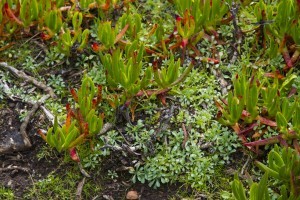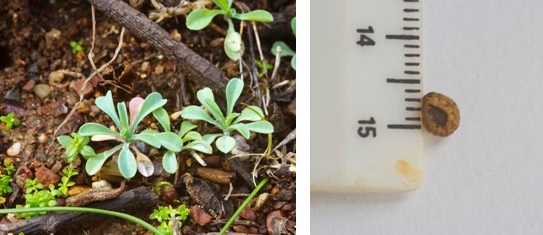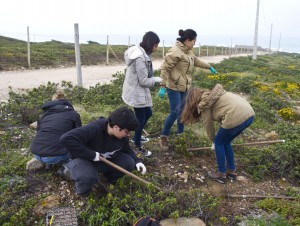The corridor from the Lighthouse in Cascais to Cabo da Roca in Sintra hides a world secret of botany, where we find the sacred stronghold of Omphalodes kunzinskyanae, best known as Myosotis of the Beach, a plant of the class of angiosperms (flowering plants), endemic in this region.
This is a kind of a hollow seed with the shape of a navel and a coiled hairy cover. The name “Omphalodes”, “umbilicus” in Latin, comes from the aspect of the seed, released by the plant. The botanist who first described the genus to the scientific community – Miller, in the eighteenth century – saw the unusual shape of the fruit as a navel. Kunzinskanae comes from Kunzinsky, Polish botanist who visited our country with Willkomm, the German naturalist who discovered this species in 1889.
Omphalodes kunzinskyanae or Myosotis of the Beach is a species of Boraginaceae and a Lusitanian endemic which can only be found in Sintra-Cascais Natural Park, with a high risk of getting endangered. It’s an annual small plant, sprouting from November to mid-February, and, usually in March, its blue-white flowers appear. Omphalodes kunzinskyanae is a harmless and herbaceous species which is rarely a span high and with a relatively short life time (ending in June).
This species grows in porous and sandy soils, with carbonates, such as Abano. According to Irene Correia, an Engineer at Environment Cascais Agency, Myosotis of the Beach is a plant with an inconstant population, that is, the number of individuals greatly varies from year to year due not only to the action of man but also to the weather conditions as well as to the changes in the soil characteristics, to which it is very sensitive.
The Environment Cascais Agency is developing a project aiming at the protection and preservation of this species. During January and February there were plantations of young individuals, which had been grown in greenhouse from seeds collected from the natural habitat in March and April 2013.
Students from Colégio Valsassina followed this action and they are developing a project to study the new populations and the possible spread of the area of the Omphalodes kunzinskyanae.
It was used the method of the transect, with square areas limited by wooden stakes and string. Due to this method it was possible to count the individuals of this species in the considered area and monitor their development during the study period.
Several international agreements for biodiversity preservation, signed by Portugal, give it the highest status of protection, including the Berne Convention and the EU Directive for the Conservation of Habitats and Biological Diversity.
This endemic species, due to its vulnerable state, is the target of “The Red List of Threatened Species IUCN” and “National Plan of Conservation of Plant in Danger”, as it is a priority species as regards conservation, with a status defined by law; this status is also confirmed by several international agreements for the conservation of biodiversity signed by Portugal. Although the number of securing sites is not yet fully defined, it is stated the decrease of individuals capable of reproducing, because of urbanization, fires and invasive species. The current population of the species consists of about 40000 – 50000 individuals, a figure that also tends to decrease. Today there are still 9 settlements, restricted to an area of about 5.2 hectares. It is seen a very high decrease in the population of this species.

Pic.4 – Habitat occupation by invasive exotic species, such as the willow, is one of the threats to the population of Myosotis of the Beach.
Climate changes can affect biodiversity directly (threatening the survival of some species) or indirectly (through the increase of burnt areas or the biological invasions).
Some populations, especially those with a limited geographical distribution, small habitat areas or a reduced number of individuals (e.g. Myosotis of the Sands), may not have the capacity to adapt to quick climate changes. The extinction of some species is related to the low reproduction rate as well as the low dispersion.
On the coast of Cascais, close to Guincho and the beach of Abano, plant species such as Myosotis of the Beach (Omphalodes kunzinskyanae), the Carnation of Cascais (Diathus cintranus subsp. Cintranus), the Roman-Carnation (Armeria pseudarmeria) and the Fetus-Ivy-Sheet (Asplenium hemionitis) are in isolated populations, being very vulnerable to environmental conditions and climate changes. As populations whose individuals are not numerous, these species are at a greater danger of extinction.
In turn, the so-called “grey dunes” (fixed coastal dunes with herbaceous vegetation) and “green dunes”, which are, for example, between Praia da Adraga and Praia Grande, are also suffering the consequences of the environmental changes. Again, the endemism of Myosotis of the Beach, with only 9 cores restricted to an area of 5 ha in 2008 and with a long history of regression, deserves a special reference.
Unless adaptation measures are taken and the other factors of pressure on these species are neutralized, the decline will continue. This situation is worsened by the spread of invasive species.
This Myosotis is a rare species, either in the number of individuals or in the geographical distribution or in their habitats. That is why all the efforts for the conservation of this species are important.
Thanks:
This project wouldn’t have been possible without the support and availability of Cascais Ambiente. We also thank Dr Sara Saraiva and Eng Irene Correia, for all their attention, kindness and collaboration.






You must be logged in to post a comment.